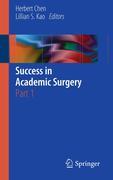
How does one become a successful academic surgeon? The Association for Academic Surgery. has been teaching this to medical students, residents, and youngfaculty for the over 20 years and this is the first time the experience and lessons learned have been summarized in a book format.. Success in Academic Surgery, Part 1, reinforces the curriculum of the Association for Academic Surgery courses and also provides guidance to individual surgeons who have not had the opportunity to attend these courses. Thus, this book is a valuable reference for medical students, surgical residents, and young surgical faculty. Developed in collaboration with the AAS, the largest organization of academic surgeons in the world with over 3,000 members.. Linked with an ongoing successful course, which is in its 21st year, and has been supported by grants from the NIH.. Written by experts in the world of academic surgery and active members of the AAS. INDICE: Why Be an Academic Surgeon? Impetus and Options for the Emerging Surgeon-Scientist. Timeline for Promotion/Overview of an Academic Career. Reviewing the Literature/Developing a Hypothesis, Study Design. Ethics in Surgical Research. -. Analyzing Your Data. Animal Models for Surgical Research. Health Services Research. Surgical Educational Research: Getting Started. Translational Research and New Approaches: Genomics, Proteomics, and Metabolomics. How toWrite and Revise a Manuscript for Peer Review Publication. Choosing, and Being, a Good Mentor. Writing a Grant/Obtaining Funding. Setting Up a “Lab” (Clinical or Basic Science Research Program) and Managing a Research Team. Work-LifeBalance and Burnout. Time Management.
- ISBN: 978-0-85729-312-1
- Editorial: Springer London
- Encuadernacion: Rústica
- Páginas: 246
- Fecha Publicación: 30/09/2011
- Nº Volúmenes: 1
- Idioma: Inglés
